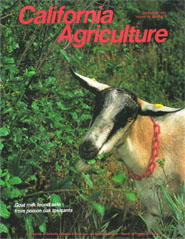All Issues

Goat milk found safe from poison oak toxicants
Cover:
Dairy goats may soon receive increased use statewide in biological control of poison oak. Studies underway at UC Davis indicate goats fed poison oak do not produce milk containing the toxicant.
Photo by Jack Kelly Clark
May-June 1992
Volume 46, Number 3
Volume 46, Number 3





